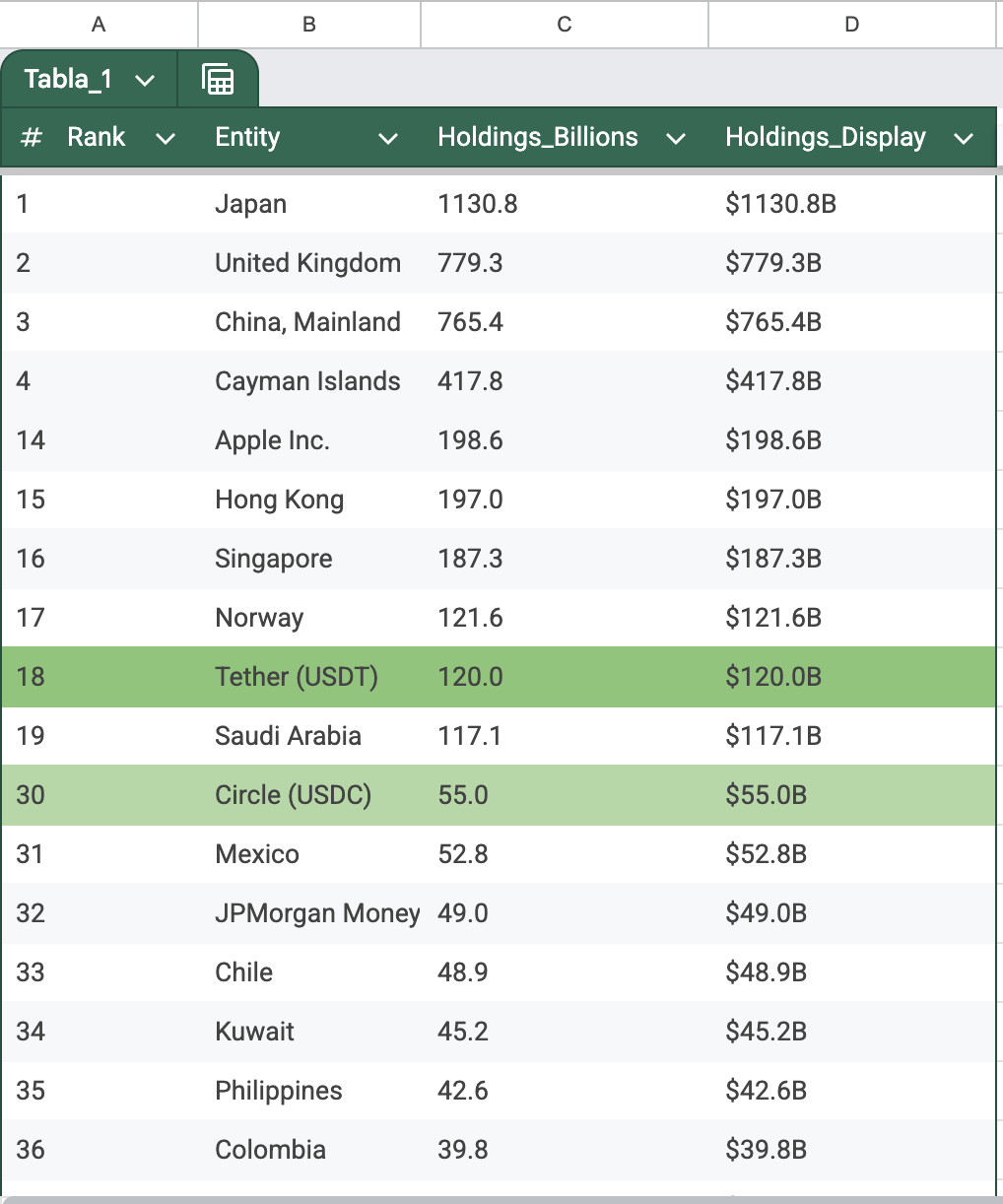When Digital Money Eats Government Debt.
Do you ever thought this is how the future will look like?
Last Thursday was Circles' IPO, and it was outstanding at some point; the positions were sold up to +160% of the initial valuation. This is when I ask myself, you create a digital currency, this digital currency is pegged into a dolar that you have in your treasury as a collateral, whe you are big enough you go to the stock exchange to collateralize even more that debt treasury that you already have, and you get to sell it 160% more expensive that expected. Does money really exist?
Look, I know what you're thinking: "Another week, another existential crisis about whether money is real." And honestly, fair point. But this week, we need to talk about something that's happening right now that makes the plot of *The Matrix* look like a documentary about accounting.
We're living in a world where digital tokens, essentially fancy Excel spreadsheets with blockchain sprinkles, now hold more U.S. Treasury debt than entire countries. Tether, a company, now owns $120 billion in U.S. government debt, making it the 18th largest holder globally, surpassing Germany. Yes, Germany, the country that gave us the autobahn, Oktoberfest, and an unsettling efficiency in everything they do, holds less American debt than a stablecoin company that keeps its cash in what is essentially the world's most expensive digital piggy bank.
And here's the kicker: stablecoins now absorb 12% of all Treasury issuances and hold 4.7% of all outstanding Treasury debt. To put that in perspective, these digital dollars are basically becoming the Treasury market's biggest customers, right behind countries that actually, you know.
When Digital Money Absorbs Treasury Debt, Does Money Actually Exist?
This is where things get properly philosophical, in the way that only modern finance can make your brain hurt. When Tether takes your dollars and immediately converts them into Treasury bills to back their USDT tokens, they're essentially creating a digital photocopy of money backed by government debt. It's like monetary inception, digital money backed by promises from a government that prints money to pay for the debt that backs the digital money.
Here's what's happening: You give Tether $100, they buy $100 worth of Treasury bills, and give you 100 USDT tokens that are supposedly worth $100. But here's the existential question that keeps economists awake at night: Is that USDT money, or is it just a receipt for money that's been converted into government debt?
The answer, frankly, is that money stopped being "real" in any meaningful sense decades ago when we left the gold standard (Tether is working on that also). What we're witnessing now is just the latest evolution in humanity's longest-running confidence game. Stablecoins have simply made explicit what was always true: money is just collective belief backed by institutional promises.
But the really wild part? The new stablecoin legislation explicitly classifies these tokens as "payment instruments" rather than securities, essentially saying: "Yes, this digital representation of debt-backed value is legally equivalent to money". Congress has basically looked at this monetary Rube Goldberg machine and said, "Sure, that's fine. That's money now."
So now, Stablecoins are more secure than actual banks?
Now let's talk about Circle, the company that positions itself as the "responsible" stablecoin issuer, the one that wears suits to crypto conferences and probably has PowerPoint presentations about regulatory compliance. In March 2023, Circle had $3.3 billion of USDC reserves sitting in Silicon Valley Bank right when it collapsed, causing USDC to temporarily depeg to $0.87.
The irony here is so thick you could spread it on toast. Circle, a company that exists specifically because traditional banking is supposedly slow and unreliable, got absolutely wrecked by... traditional banking being slow and unreliable. It's like starting a submarine company because you don't trust boats, only to have your submarine sink because you built it in a leaky boat factory.
But here's what's truly maddening: This is still happening in 2025. Circle continues to maintain banking relationships that create single points of failure, despite positioning itself as the future of money. They've learned from SVB by diversifying their banking partners, but they're still fundamentally dependent on the same traditional banking infrastructure they claim to be disrupting. It's like trying to escape the Matrix but insisting on keeping your phone number from inside the Matrix because "people need to be able to reach you."
The real kicker? Circle's entire business model depends on interest earned from parking customer deposits in traditional banks and Treasury securities, and YES, it works; they made $1.68 billion in revenue in 2024, with over 99% coming from interest income. They're essentially a money market fund cosplaying as a technology company.
AGI Readiness vs. Compliance Readiness: The Ultimate Nerd Fight
This brings us to the most fascinatingly nerdy corporate strategy battle of our time: Tether betting on artificial general intelligence while Circle bets on regulatory compliance. It's like watching two very different approaches to surviving the apocalypse, one person stockpiling canned goods and bunker supplies, the other learning to code and hoping the robots will like them.
Tether's AGI Strategy:
Tether is going full sci-fi villain with their approach. They've launched Tether AI, a decentralized artificial intelligence platform that natively supports Bitcoin and USDT payments through peer-to-peer networks. Their CEO, Paolo Ardoino, literally said they want to create the "ideal technological foundation" for realizing Isaac Asimov's AI vision. This is either brilliant forward-thinking or the setup for a dystopian novel where AI agents pay each other in stablecoins.
The pros: If AGI actually arrives and needs a payment system, Tether is positioning itself as the financial infrastructure for our robot overlords. They're building a system where AI agents can autonomously transact without human oversight, which sounds terrifying but could be incredibly lucrative.
The cons: They're essentially betting the farm on technology that doesn't exist yet, while maintaining a business model that depends on current financial infrastructure. Also, their "fully open-source AI runtime" strategy means they're giving away the very technology they hope will differentiate them.
Circle's Compliance Strategy:
Circle, meanwhile, is playing the long game of regulatory legitimacy. They've secured MiCA compliance in the EU, they're publicly traded with BlackRock as a major investor, and they've built API infrastructure that actually makes sense for enterprise adoption. They're basically the kid who always did their homework, hoping the teacher would notice.
The pros: When institutions want to use stablecoins, they choose Circle because it won't get them fired. Their programmable wallets and API-driven approach make integration straightforward for traditional financial institutions. Plus, being a public company means enhanced transparency and oversight.
The cons: Regulatory compliance is expensive and slow. Circle paid over $1 billion in distribution costs in 2024, mostly to Coinbase, while Tether operates with much lower overhead. They're building for the world that regulators want, not necessarily the world that's coming.
Who's Winning?
Honestly? Both strategies could work, which is what makes this fascinating. Tether dominates market share with 67% of the stablecoin market versus Circle's 27%, but Circle is growing faster in institutional adoption. Tether is preparing for a future where AI agents need autonomous payment systems, while Circle is building infrastructure for a present where banks need compliant digital dollar solutions.
The real answer might be that they're not even competing for the same market. Tether is building the payment rails for the autonomous agent economy, while Circle is building the on-ramp for traditional finance to enter the digital asset space.
The Evolution of Programmable Money: From Securities to Payment Systems
Here's where things get properly mind-bending in the best possible way. The recent stablecoin legislation doesn't just regulate these tokens, it fundamentally redefines what money can be by classifying stablecoins as payment instruments rather than securities.
This distinction matters more than you might think. Securities are investments; payment instruments are money. By legislating stablecoins as payment systems, Congress has essentially said: "Digital tokens with programmable functionality are legally equivalent to traditional money".
What this means is revolutionary: money can now be programmed with conditions, automatic execution, and smart contract functionality while maintaining full legal status as a payment instrument. Imagine money that automatically splits restaurant bills, pays rent only after lease conditions are met, or executes international transfers without correspondent banking.
Circle's programmable wallets demonstrate this evolution perfectly; they've built APIs that allow businesses to automate USDC transactions based on smart contract conditions, essentially creating money that executes business logic automatically. Stripe's integration of stablecoins with AI-powered payment routing shows how this programmable money can optimize itself in real-time based on cost, speed, and risk assessments.
This represents the most significant evolution in monetary technology since the invention of banking itself. We're moving from money as a store of value to money as executable code—digital assets that can carry their own terms, conditions, and automated behaviors while maintaining the legal status and consumer protections of traditional payment systems.
The implications are staggering. Every financial contract, every payment agreement, every business transaction can now be encoded directly into the money itself. We're not just digitizing currency; we're making currency intelligent.
And the beautiful irony? This transformation is happening not through some libertarian cryptocurrency revolution, but through boring regulatory classification in Congressional committee rooms. The future of programmable money is being built by compliance officers and payment processors, not anarchist coders.
The revolution will be bureaucratized.
---
Comparative Treasury Holdings Analysis: Stablecoin Reserves vs. National & Corporate Holdings (Q1 2025)
Click here if you want to see the full table.
*Sources: U.S. Treasury Department, Tether Holdings Ltd., Circle Internet Financial Ltd., Federal Reserve Economic Data*
---
*P.S. - If you enjoyed this existential crisis disguised as financial analysis, please subscribe, share, and remember: in a world where digital tokens backed by government debt can legally qualify as money, the only rational response is to embrace the absurdity and try to profit from it responsibly.*






